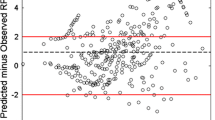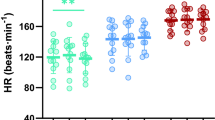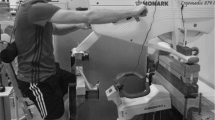Abstract
This study tested the hypothesis that the increase in rating of perceived exertion (RPE) predicts the duration of exercise to exhaustion during exercise in hot conditions. Seven subjects performed five cycling trials in an environmental chamber at temperatures of 15°C (C) and 35°C (H). The cool trials were performed at intensities of 65 and 70% and the hot trials at 55, 60 and 65%. RPE, rectal and skin temperature were measured during trials. Duration to fatigue was significantly shorter in H65 and C70 than H60, C65 and H55 (P < 0.05). RPE rose linearly throughout each trial and the rate of increase in RPE was significantly faster in H65 and C70 than H55 (P < 0.05). There was an inverse linear relationship between trial duration and rate of increase in RPE (r = 0.83). Rectal temperature increased linearly throughout the trial and correlated significantly with RPE (r = 0.92). This study shows that the rate of increase in RPE predicts the duration of exercise to exhaustion at a constant power output in different environmental conditions.









Similar content being viewed by others
References
Albertus Y, Tucker R, St Clair GA, Lambert EV, Hampson DB, Noakes TD (2005) Effect of distance feedback on pacing strategy and perceived exertion during cycling. Med Sci Sports Exerc 37:461–468
Baldwin J, Snow RJ, Gibala MJ, Garnham A, Howarth K, Febbraio MA (2003) Glycogen availability does not affect the TCA cycle or TAN pools during prolonged, fatiguing exercise. J Appl Physiol 94:2181–2187
Borg GA (1982) Psychophysical bases of perceived exertion. Med Sci Sports Exerc 14:377–381
Colin J, Timbal J, Houdas Y, Boutelier C, Guieu JD (1971) Computation of mean body temperature from rectal and skin temperatures. J Appl Physiol 31:484–489
Eston RG, Lamb KL, Parfitt G, King N (2005) The validity of predicting maximal oxygen uptake from a perceptually-regulated graded exercise test. Eur J Appl Physiol 94:221–227
Eston RG, Faulkner JA, Mason EA, Parfitt G (2006) The validity of predicting maximal oxygen uptake from perceptually regulated graded exercise tests of different durations. Eur J Appl Physiol 97:535–541
Eston R, Faulkner J, St Clair GA, Noakes T, Parfitt G (2007) The effect of antecedent fatiguing activity on the relationship between perceived exertion and physiological activity during a constant load exercise task. Psychophysiology 44:779–786
Eston R, Lambrick D, Sheppard K, Parfitt G (2008) Prediction of maximal oxygen uptake in sedentary males from a perceptually regulated, sub-maximal graded exercise test. J Sports Sci 26:131–139
Galloway SD, Maughan RJ (1997) Effects of ambient temperature on the capacity to perform prolonged cycle exercise in man. Med Sci Sports Exerc 29:1240–1249
Garcin M, Billat V (2001) Perceived exertion scales attest to both intensity and exercise duration. Percept Mot Skills 93:661–671
Garcin M, Vautier JF, Vandewalle H, Wolff M, Monod H (1998) Ratings of perceived exertion (RPE) during cycling exercises at constant power output. Ergonomics 41:1500–1509
Garcin M, Vandewalle H, Monod H (1999) A new rating scale of perceived exertion based on subjective estimation of exhaustion time: a preliminary study. Int J Sports Med 20:40–43
Garcin M, Wolff M, Bejma T (2003) Reliability of rating scales of perceived exertion and heart rate during progressive and maximal constant load exercises till exhaustion in physical education students. Int J Sports Med 24:285–290
Gonzalez-Alonso J, Teller C, Andersen SL, Jensen FB, Hyldig T, Nielsen B (1999) Influence of body temperature on the development of fatigue during prolonged exercise in the heat. J Appl Physiol 86:1032–1039
Hawley JA, Noakes TD (1992) Peak power output predicts maximal oxygen uptake and performance time in trained cyclists. Eur J Appl Physiol Occup Physiol 65:79–83
Horstman DH, Morgan WP, Cymerman A, Stokes J (1979) Perception of effort during constant work to self-imposed exhaustion. Percept Mot Skills 48:1111–1126
Joseph T, Johnson B, Battista RA, Wright G, Dodge C, Porcari JP, deKoning JJ, Foster C (2008) Perception of fatigue during simulated competition. Med Sci Sports Exerc 40:381–386
Marino FE, Lambert MI, Noakes TD (2004) Superior performance of African runners in warm humid but not in cool environmental conditions. J Appl Physiol 96:124–130
Montain SJ, Coyle EF (1992) Influence of graded dehydration on hyperthermia and cardiovascular drift during exercise. J Appl Physiol 73:1340–1350
Morgan WP, Borg GAV (1976) Perception of effort in the prescription of physical activity. In: Craig T (ed) The humanistic and mental health aspects of sports. Exercise and RecreationAmerican Medical Association, Chicago, pp 126–129
Nethery VM (2002) Competition between internal and external sources of information during exercise: influence on RPE and the impact of the exercise load. J Sports Med Phys Fitness 42:172–178
Nielsen B, Hales JR, Strange S, Christensen NJ, Warberg J, Saltin B (1993) Human circulatory and thermoregulatory adaptations with heat acclimation and exercise in a hot, dry environment. J.Physiol 460:467–485
Nielsen B, Hyldig T, Bidstrup F, Gonzalez-Alonso J, Christoffersen GR (2001) Brain activity and fatigue during prolonged exercise in the heat. Pflugers Arch 442:41–48
Noakes TD (2004) Linear relationship between the perception of effort and the duration of constant load exercise that remains. J Appl Physiol 96:1571–1572
Noakes TD, St Clair Gibson A (2004) Logical limitations to the “catastrophe” models of fatigue during exercise in humans. Br J Sports Med 38:648–649
Noakes TD, St Clair Gibson A, Lambert EV (2005) From catastrophe to complexity: a novel model of integrative central neural regulation of effort and fatigue during exercise in humans: summary and conclusions. Br J Sports Med 39:120–124
Nybo L, Nielsen B (2001a) Hyperthermia and central fatigue during prolonged exercise in humans. J Appl Physiol 91:1055–1060
Nybo L, Nielsen B (2001b) Perceived exertion is associated with an altered brain activity during exercise with progressive hyperthermia. J Appl Physiol 91:2017–2023
Ramanathan NL (1964) A new weighting system for mean surface temperature of the human body. J Appl Physiol 19:531–533
Saltin B, Hermansen L (1966) Esophageal, rectal, and muscle temperature during exercise. J Appl Physiol 21:1757–1762
St Clair Gibson A, Noakes TD (2004) Evidence for complex system integration and dynamic neural regulation of skeletal muscle recruitment during exercise in humans. Br J Sports Med 38:797–806
St Clair Gibson A, Lambert EV, Rauch LH, Tucker R, Baden DA, Foster C, Noakes TD (2006) The role of information processing between the brain and peripheral physiological systems in pacing and perception of effort. Sports Med 36:705–722
St Clair Gibson A, Baden DA, Lambert MI, Lambert EV, Harley YX, Hampson D, Russell VA, Noakes TD (2003) The conscious perception of the sensation of fatigue. Sports Med 33:167–176
Tatterson AJ, Hahn AG, Martin DT, Febbraio MA (2000) Effects of heat stress on physiological responses and exercise performance in elite cyclists. J Sci Med Sport 3:186–193
Tucker R, Rauch L, Harley YX, Noakes TD (2004) Impaired exercise performance in the heat is associated with an anticipatory reduction in skeletal muscle recruitment. Pflugers Arch 448:422–430
Tucker R, Marle T, Lambert EV, Noakes TD (2006) The rate of heat storage mediates an anticipatory reduction in exercise intensity during cycling at a fixed rating of perceived exertion. J Physiol 574:905–915
Ulmer HV (1996) Concept of an extracellular regulation of muscular metabolic rate during heavy exercise in humans by psychophysiological feedback. Experientia 52:416–420
Walters TJ, Ryan KL, Tate LM, Mason PA (2000) Exercise in the heat is limited by a critical internal temperature. J Appl Physiol 89:799–806
Watson P, Hasegawa H, Roelands B, Piacentini MF, Looverie R, Meeusen R (2005) Acute dopamine/noradrenaline reuptake inhibition enhances human exercise performance in warm, but not temperate conditions. J Physiol 565:873–883
Author information
Authors and Affiliations
Corresponding author
Rights and permissions
About this article
Cite this article
Crewe, H., Tucker, R. & Noakes, T.D. The rate of increase in rating of perceived exertion predicts the duration of exercise to fatigue at a fixed power output in different environmental conditions. Eur J Appl Physiol 103, 569–577 (2008). https://doi.org/10.1007/s00421-008-0741-7
Accepted:
Published:
Issue Date:
DOI: https://doi.org/10.1007/s00421-008-0741-7




